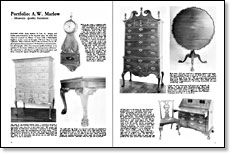
Synopsis: Andy Marlow designs and builds period furniture in the classical styles. Here are seven pieces from his collection each accompanied with his comments.
EDITOR’S NOTE: Andy Marlow of York, Pa., designs and builds period furniture in the classical styles. He writes that when he received our Winter ’77 issue (with a Philadelphia highboy on the cover) he thought, “Oh boy! There is a real craftsman. What a letdown when I discovered it to be an oft photographed museum piece.” He therefore volunteered select photographs of his own museum-quality furniture, as an antidote “to the brain-children of contemporary craftsmen.”
We asked him to add what he recalled about each piece, and those comments appear alongside the photographs.
Very early in my furniture-making career, I received a call from a lumber dealer who said there was a carload of curly maple on the way and would I want some of it to fill a back order. This lumber was sight unseen by either of us. On arrival, it turned out to be beautiful 4/4 bird’s-eye maple that had slipped past the veneer makers. I used that lumber for many pieces but have only the photo of this flat-top highboy (42 in. by 22 in. by 72 in.) as a reminder. Many of you will say ‘amen’ to the observation that all one can do with bird’s-eye maple is to saw it and sand it.
Back in the 1940s, a telephone-caller asked if I would be interested in a clock removed from an old railroad waitingroom. Remembering the kind of timepieces made in those days, I was not surprised to find a well-made trapeze movement with a 19-in. pendulum. So, what kind of case to make for it? Finally settled on a lyre design like this one (42 in. by 14 in. by 5 in.). After hanging on a wall in our home for a short time, it was sold, much to my sorrow. I didn’t make another until last year when I bought a few beautifully made trapeze movements of the same size. This new case does not equal the original because the best I can get now is mahogany from Honduras. The old one was made of exceptionally fine dark-brown wood from Santo Domingo. In both cases, the dials were an odd size so I had to make them of spun aluminum.
The coffee-table leg design is a copy of a stool that was displayed in the Metropolitan Museum of Art about 1953. Coffee-table legs must be adapted from stool or chair legs that are the same height, because coffee tables as such were not made at that time. Many cabriole-leg designs are acanthus-leaf patterns, which make this carving design particularly attractive, especially when the legs end in paw feet.
From Fine Woodworking #13
For the full article, download the PDF below:
Fine Woodworking Recommended Products

Circle Guide

Drafting Tools

Compass






















Log in or create an account to post a comment.
Sign up Log in